Collard Green Wraps with Peanut Sauce
These Collard Green Vegan Wraps with creamy peanut sauce offer a fresh, healthy main dish or appetizer that is bursting with vibrant color and loads of nutrition.

Collard vegan wraps are very versatile. I stuff mine full of a hearty grain called bulgur, shredded carrots, red bell peppers, cucumber slices, and bean sprouts and drizzle them with creamy peanut sauce. The great thing is that you can fill yours up with whatever veggies and grain (or not) you prefer!
One thing we love about this recipe and all types of wraps is that they are so versatile. That is why we have a growing collection on this website like these veggie vegan wraps, our garden fresh spring roll wraps, and even these lettuce wraps from Jane & Ann Esselstyn.
Reasons you will love these wraps
- New & different- These collard green wraps with creamy peanut sauce offer a fresh and flavorful alternative to traditional wraps, perfect for a light and healthy meal.
- Wholesome- Packed with nutrient-rich ingredients, they provide a satisfying crunch and a burst of flavor in every bite.
- Versatile & customizable- Easy to customize with your favorite fillings, these wraps are versatile, making them ideal for meal prep, lunch, or a quick dinner.
Ingredients needed
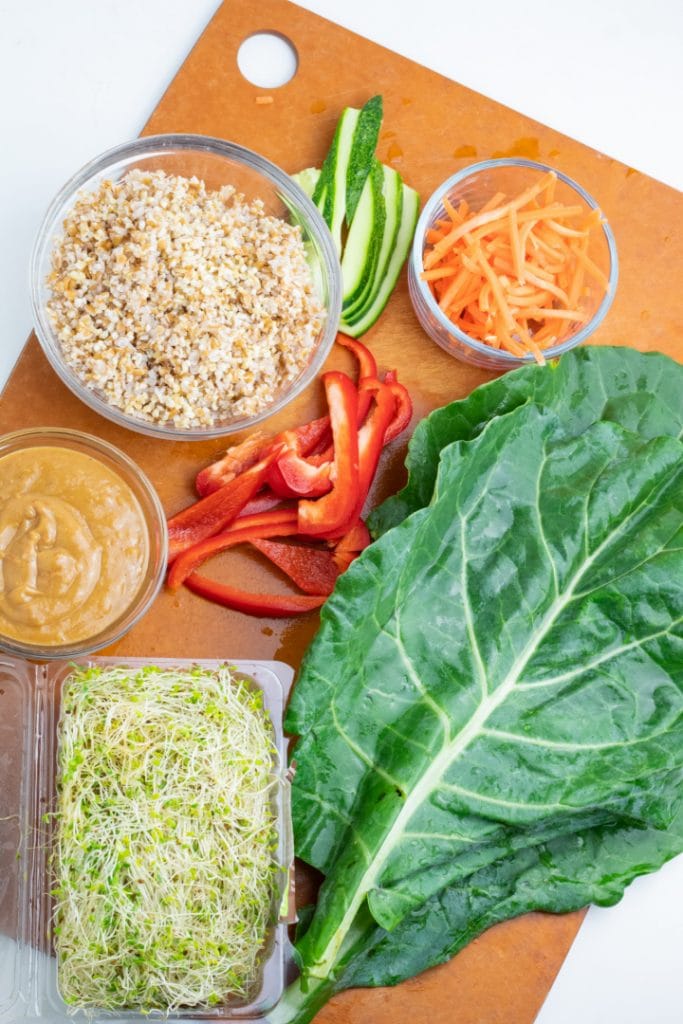
- Collard green leaves- These green leaves are perfect for making wraps because they’re sturdy, nutrient-dense, and provide a refreshing, slightly bitter flavor that complements a variety of fillings.
- Whole grain- Using a grain as a stuffing helps bulk these wraps up and make them even more filling. I use bulgur wheat. If you haven’t heard of it, we have an article all about bulgur and recipes to use it in. You could use other options of healthy grains, like quinoa, brown rice, and oats, which are nutrient-rich powerhouses that provide essential fiber, vitamins, and minerals.
- Fresh veggies- Red bell peppers, cucumbers, carrots, and bean sprouts are a great combo to start with.
- Peanut sauce- My homemade creamy peanut sauce only takes minutes to prepare, and it is the perfect dipping sauce for wraps like these and my simple garden rice wrap spring rolls.
How to make collard green wraps
The recipe card at the bottom of the page has the full list of ingredients with measurements and instructions.
These wraps are not difficult to make at all, so don’t let the length of the instructions discourage you from trying this recipe. I’ve just tried to be very detailed to make it nice and simple to follow.
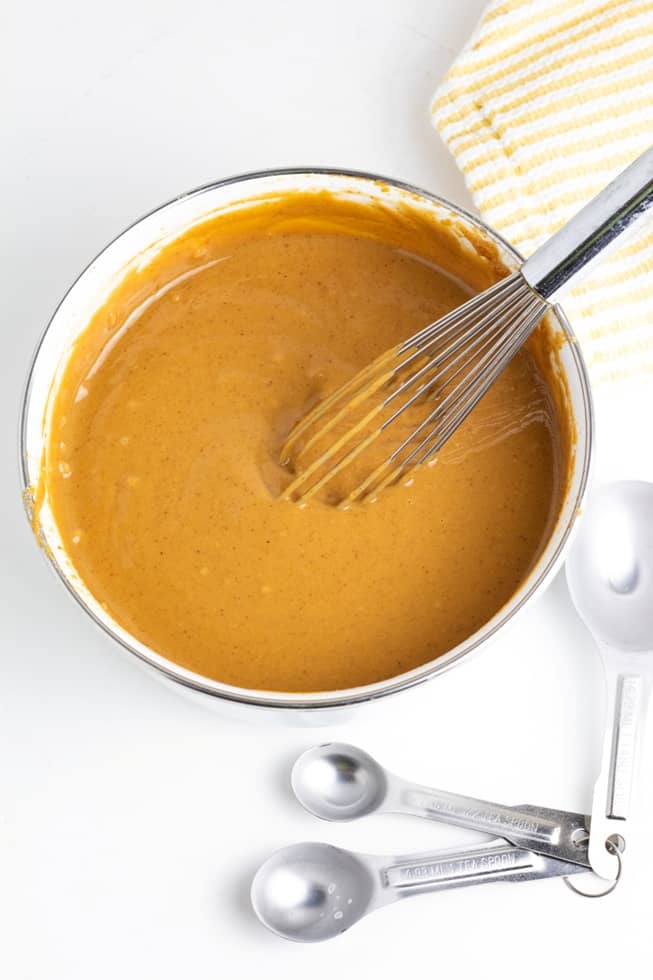
STEP #1: I like to begin by preparing the homemade healthy peanut sauce. This creamy sauce is very easy to make in about 5 minutes. Simply combine all the sauce ingredients in a bowl and whisk together until smooth.
If needed, heat the mixture in the microwave for 30 seconds to allow for more effortless blending. If it needs to be thinned a bit, just add a little more almond milk. Set to the side while you start on the wraps.
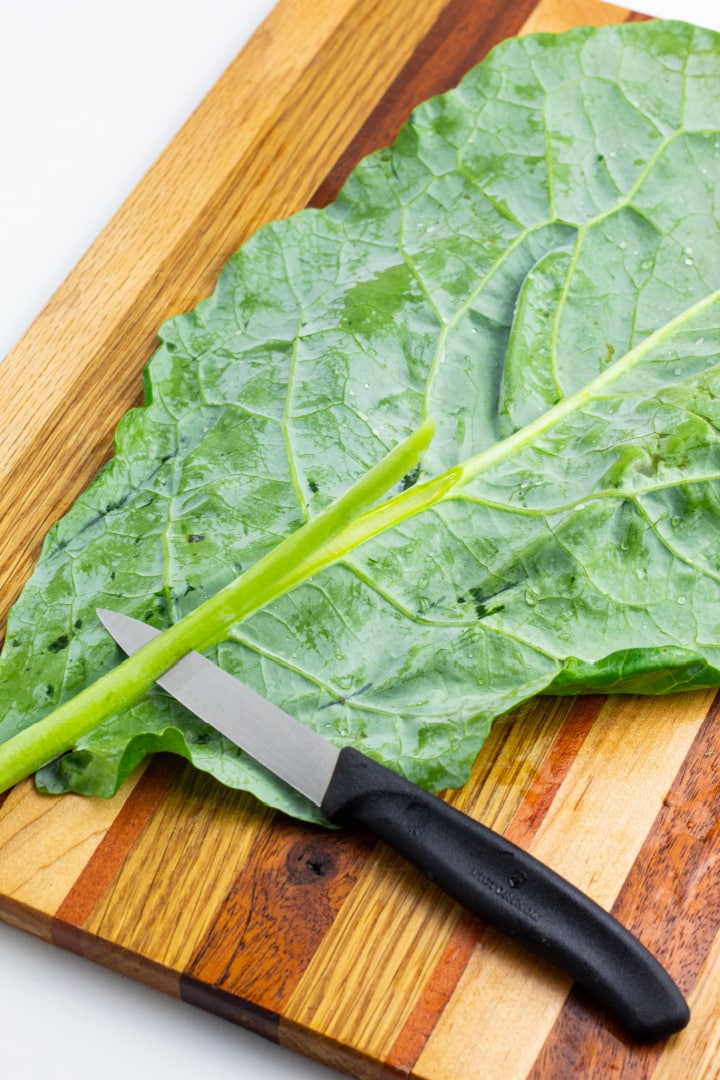
STEP #2: Collard leaves are very large and rigid. They require a few steps to make them a little easier to work with. First, lay the collard leaf on a cutting board or other flat surface and turn it with the coarse side up.
Use a sharp knife to trim the thickest part of the stem, being careful not to cut through the leaf. This will help allow the leaf to be rolled and folded without cracking and tearing. See my video that shows how easy this is to do.
STEP #3: Next, bring a pot of water to boil to parboil the leaves to make them more pliable and easy to bend when rolling. Lower the heat to medium-low. Hold the long stem of the leaf (or use tongs) and dunk it into the water for approximately 20-30 seconds, then quickly remove the leaf and lay it on a cutting board or another flat surface. Use scissors or a sharp knife to cut off the long stem to level with the bottom of the leaf.
Each leaf will need to be done separately, so don’t pile all of them in the pot together. I like to parboil all my leaves during one prep time even when I’m not planning to make all the rolls at once. This is because, once they are prepared, they keep really well in the refrigerator.

STEP #4: Now, it’s time to stuff and roll the leaf. Begin by spooning 2-3 tablespoons of cooked bulgur onto the middle of the leaf, about 1/4 of the way up the stem. Add all of the other diced and grated vegetables and drizzle with approximately 2 tablespoons of the peanut sauce.

STEP #5: Fold the side edges of the leaf over the middle-filled portion. And, make sure that your stuffing ingredients are not all pushed too far up the leaf.
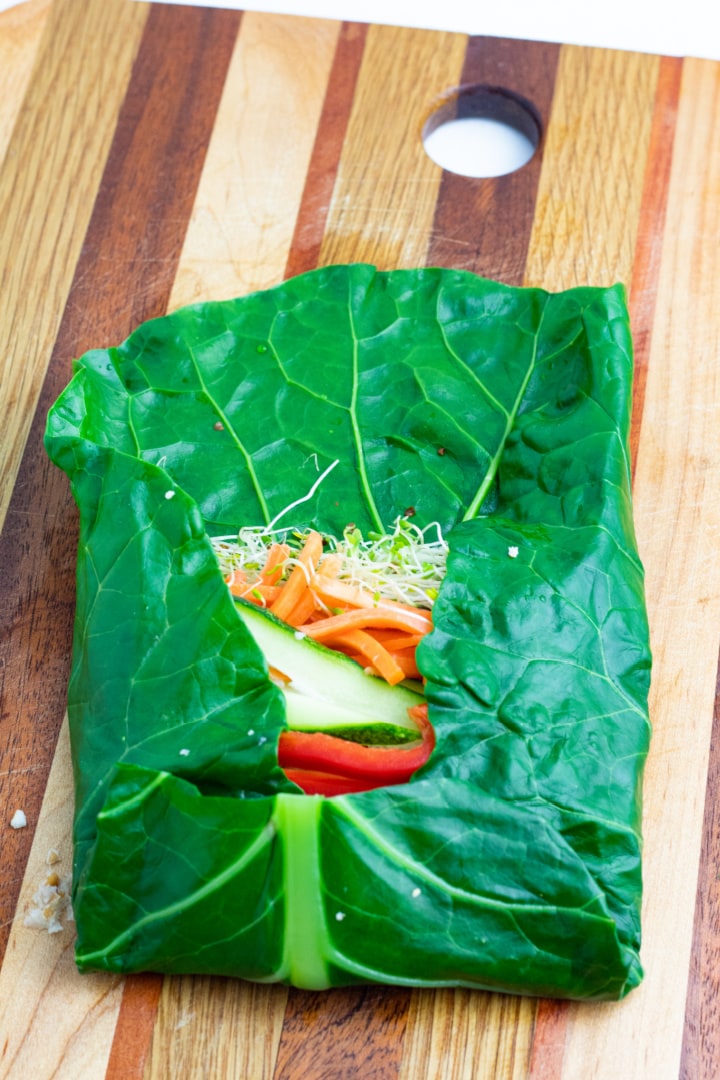
STEP #6: Next, fold the bottom (stem end) up and over the filling. It looks like you’re making a little pocket for the filling. You want it to be nice and firmly folded, but be careful not to tear the leaf.
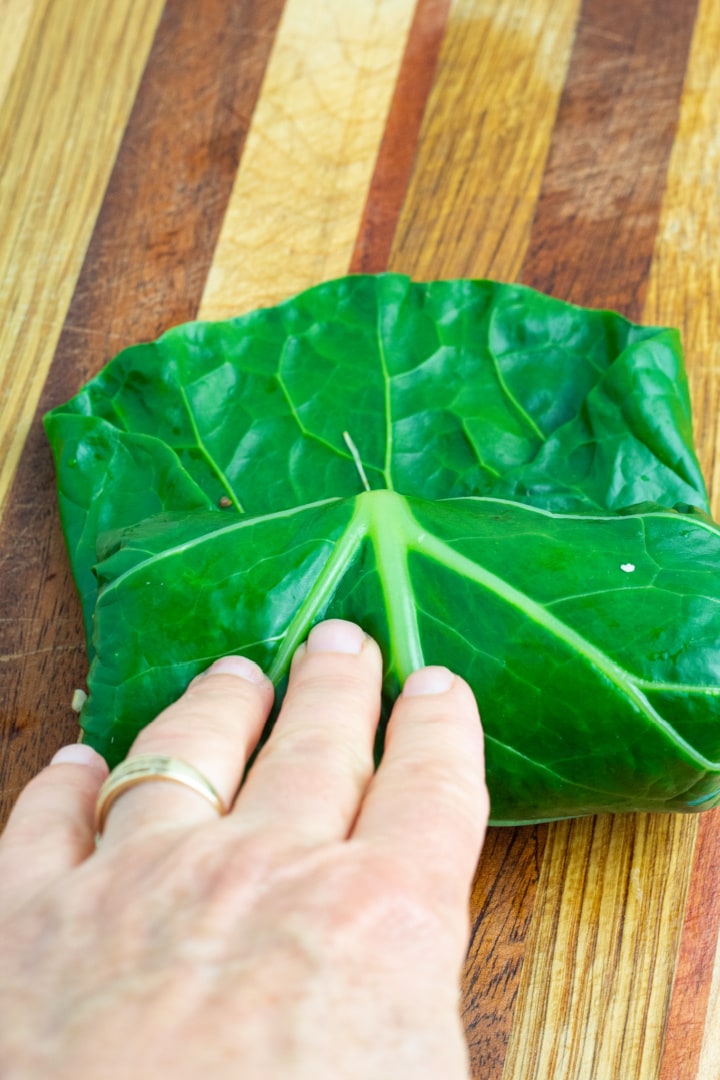
STEP #7: Begin to roll it up firmly to the end, then place the roll side down on a plate. You shouldn’t need a toothpick or anything to hold them in place because leaves are more flexible and stay in place due to blanching them in boiling water.
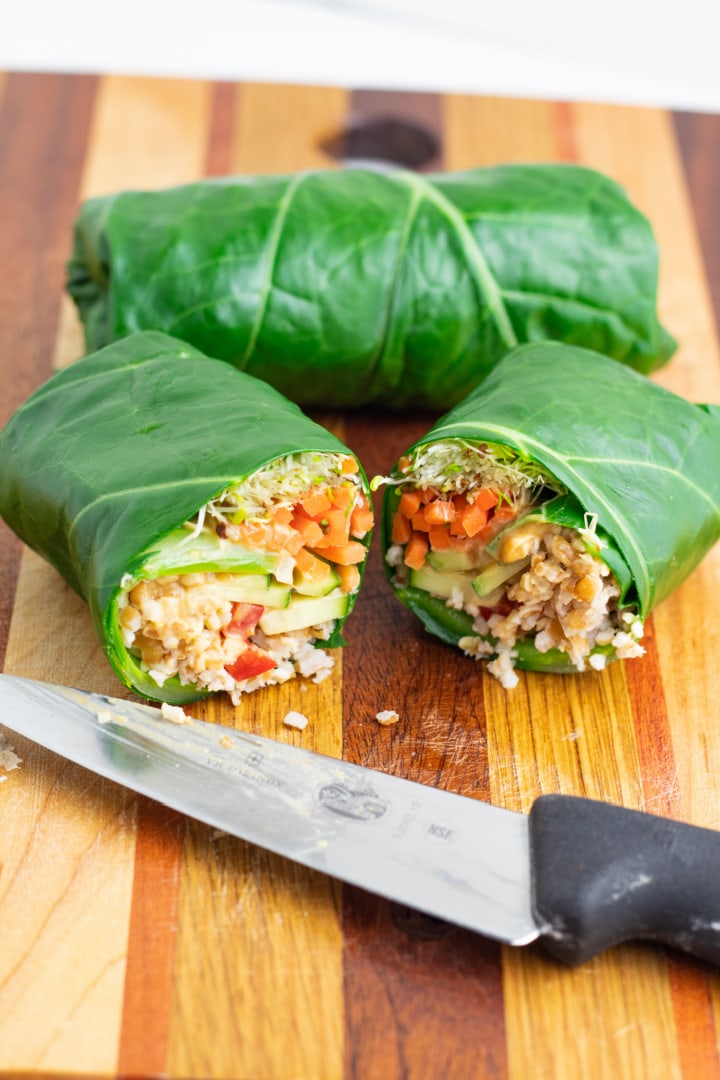
STEP #8: Lastly, use a sharp knife to slice them in the middle for easy serving because all of the colors on the inside make a beautiful and impressive display. Serve immediately with the rest of the peanut sauce for dipping. Watch the cooking demonstration to see how easy preparing this recipe can be!
I am often asked which knives I use personally, and I have to say that it is Victorinox. They are the same company that makes Swiss Army Knives and the quality is excellent.
*Originally published August 2016.
Tips & Suggestions
- GF option- Since bulgur is a wheat grain, it is not gluten-free, you might try buckwheat groats to replace it if you are gluten-sensitive.
- The leaf- When trimming the collard leaf, make sure to leave the stem on for use as a handle to dip into the boiling water.
- Bulgur- I like to make large batches of bulgur in my rice cooker and keep it in the freezer to easily add to recipes. We have a great article to answer all of your questions about how to cook with bulgur.
- Lower fat- The creamy peanut sauce can be made with peanut butter or PB2 for a lower-fat option.
Frequently Asked Questions
They can be. Since bulgur is a wheat grain, it is not gluten-free, you might try buckwheat groats to replace it if you are gluten-sensitive. Other options include quinoa and brown rice.
At my house, these wraps are usually the main course. Some great sides to serve with them include large baked sweet potatoes, corn on the cob, and Grilled Veggie Kabobs or Air-Fried Baked Potatoes.
These keep well in the refrigerator for 2-3 days. After that, they get a little chewy. They will not freeze well.
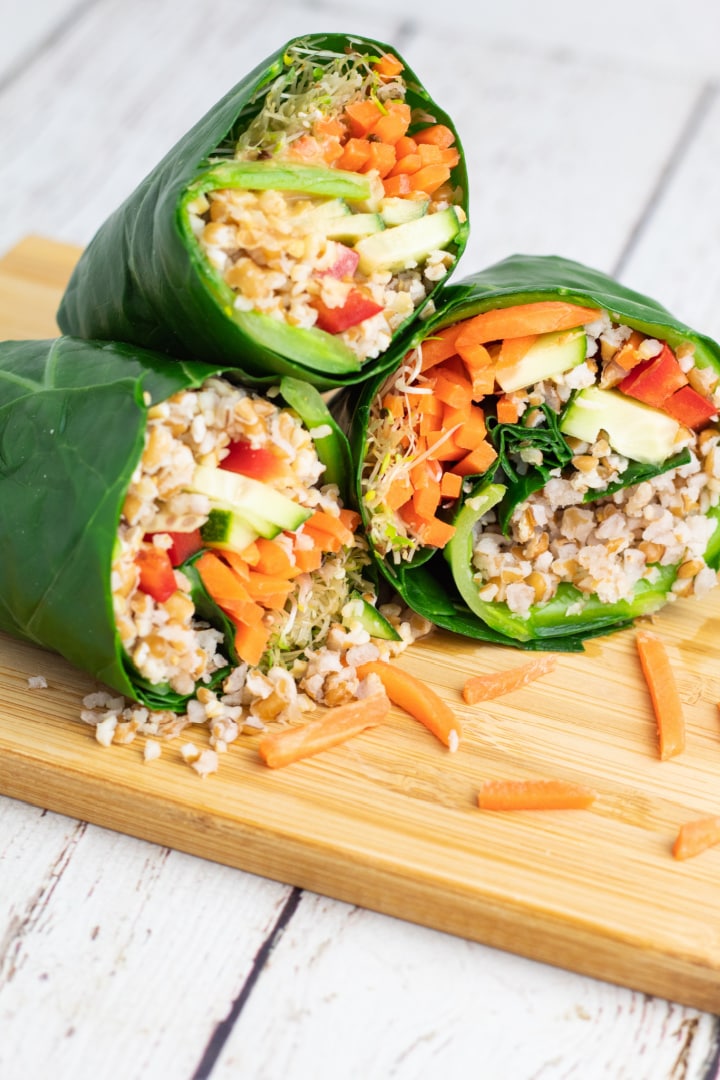
For those of you new to the whole food plant-based lifestyle, we’ve created a FREE 7-Day Plant-Based Menu Planner to help you get started!
If you try this recipe, please let us know how you like it by rating it and leaving a comment. We love to hear from you!
Want to Save This Recipe?
Enter your email & I'll send it to your inbox. Plus, get great new recipes from me every week!
By submitting this form, you consent to receive emails from EatPlant-Based
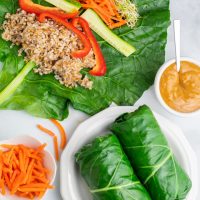
Collard Green Veggie Wraps with Creamy Peanut Sauce
Ingredients
Wrap Ingredients
- 4 whole collard green leaves
- 1 cup bulgur cooked, (this will be 1/2 cup dry/uncooked)
- 1 cup carrots grated
- 1 cup cucumber sliced into strips
- 1 cup red bell pepper sliced into strips
- 1 cup bean sprouts
- 1/2 cup peanut sauce recipe below
Peanut Sauce Ingredients
- 2 tablespoons Bragg's liquid aminos or soy sauce
- 1 tablespoon rice vinegar or red wine vinegar
- 1 teaspoon minced garlic (I use the kind in jar)
- 3 tablespoons natural peanut butter (or 6 Tbsp PB2 + 3 Tbsp water)
- 1/4 cup almond milk more if needed to thin
- 1/2 tablespoon maple syrup
- 1 teaspoon Thai chili paste or 1/4 tsp Sriracha
Instructions
- Start by preparing the peanut sauce. This creamy sauce is very easy to make in about 5 minutes. Simply combine all the sauce ingredients in a bowl and whisk together until smooth. If needed, heat the mixture in the microwave for 30 seconds to allow for easier blending. If it needs to be thinned a bit, just add a little more almond milk. Set to the side while you start on the wraps.
- Collard leaves are very large and rigid. They require a few steps to make them easier to work with.
- First, lay the collard leaf on a cutting board or other flat surface and turn it with the coarse side up. Use a sharp knife to trim the thickest part of the stem, being careful not to cut through the leaf. This will help allow the leaf to be rolled and folded without cracking and tearing. See my video that shows how easy this is to do.
- Next, bring a pot of water to boil to parboil the leaves to make them more pliable and easy to bend when rolling. Lower the heat to medium-low. Hold the long stem of the leaf (or use tongs) and dunk it into the water for approximately 20-30 seconds, then quickly remove the leaf and lay it on a cutting board or another flat surface.
- Each leaf will need to be done separately, so don’t pile all of them in the pot together. I like to parboil all my leaves during one prep time even when I’m not planning to make all the rolls at once. This is because, once they are prepared, they keep really well in the refrigerator.
- Use scissors or a sharp knife to cut off the long stem to level with the bottom of the leaf.
- Now, it’s time to stuff and roll the leaf. Begin by spooning 2-3 tablespoons of cooked bulgur onto the middle of the leaf, about 1/4 of the way up the stem.
- Add all of the other diced and grated vegetables and drizzle with approximately 2 tablespoons of the peanut sauce.
- Fold the side edges of the leaf over the middle-filled filled portion. And, make sure that your stuffing ingredients are not all pushed too far up the leaf. See my instructional photos to help with this.
- Next, fold the bottom (stem end) up and over the filling. It looks like you’re making a little pocket for the filling. You want it to be nice and firmly folded, but be careful not to tear the leaf.
- Begin to roll it up firmly to the end, then place the roll side down on a plate. You shouldn’t need a toothpick or anything to hold them in place because leaves are more flexible and stay in place due to the blanching in boiling water step above.
- Lastly, use a sharp knife to slice them in the middle for easy serving because all of the colors on the inside make a beautiful and impressive display.
- Serve immediately with the rest of the peanut sauce for dipping.
Video
Notes
- GF option- Since bulgur is a wheat grain, it is not gluten-free, you might try buckwheat groats to replace it if you are gluten-sensitive.
- Leaf Trimming- When trimming the collard leaf, make sure to leave the stem on for use as a handle to dip into the boiling water.
- Bulgur- I like to make large batches of bulgur in my rice cooker and keep it in the freezer to easily add to recipes. We have a great article to answer all of your questions about how to cook with bulgur.
- Lower fat- The creamy peanut sauce can be made with peanut butter or PB2 for a lower-fat option.
- Storing- These keep well in the refrigerator for 2-3 days. After that, they get a little chewy.
Nutrition
Disclaimer
To obtain the most accurate representation of the nutritional information in a given recipe, you should calculate the nutritional information with the actual ingredients used in your recipe, using your preferred nutrition calculator. You are solely responsible for ensuring that any nutritional information provided is accurate, complete, and useful.
About Terri Edwards
Hi guys! I am the content creator behind EatPlant-Based and a licensed Food for Life instructor with the Physicians Committee for Responsible Medicine. I am passionate about sharing healthy recipes and tips to empower others to get healthy. I’m so glad you’re here! Read More…

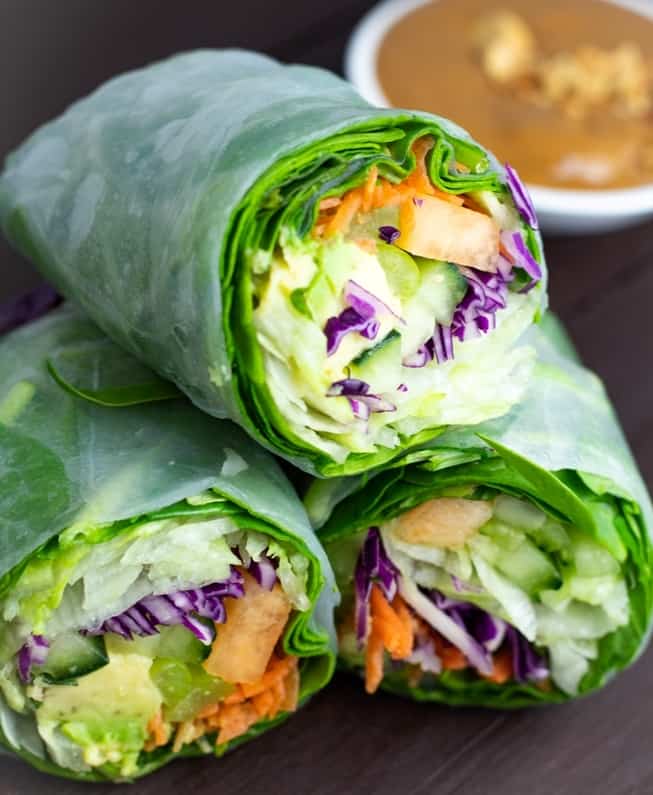
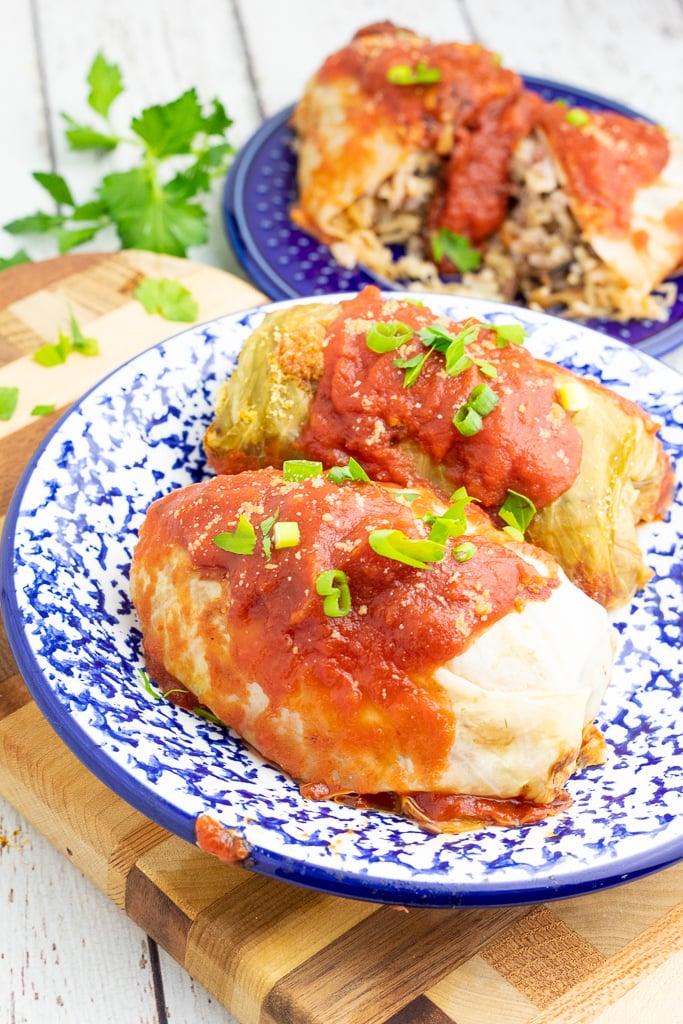
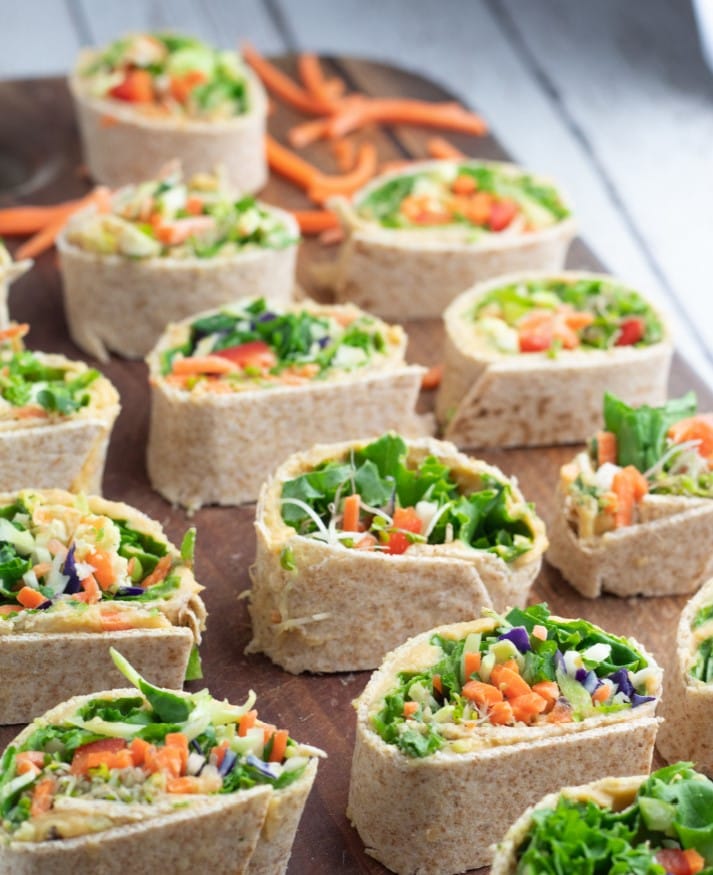


Could you sub green cabbage for the collard greens? Being close to St. Patrick’s day, green cabbage is on sale!!
You sure could, and I have a stuffed cabbage roll recipe that would be perfect too!
LOVE this recipe just the way it is! My family, however, is not crazy about the chewiness of the collards, so we make “Inside Out” Collard Wraps. I make a bowl with the same ingredients but chiffonade the collard greens. And I double the peanut sauce recipe so we can be generous. The sauce freezes well & doubles as a delicious salad dressing.
I made this recipe for my son’s family. They loved it!
Kelly- YAY! I love hearing that!
When you cook up the batch of bulgur for the recipes, do you add onions or any seasonings? Or just plain cooked with water
Marcy, I cook a batch of bulgur in my rice steamer with nothing added but water. When I use it later in recipes, that’s when I add spices and seasonings.
I thought it was very good, although I had to cook my collards for 1 full minute, each leaf. But over all, they were very good. I love the use of bulgar in it. Nutty and filling!
I’m not understanding you peanut butter sub either. Why would it take 3/4 of a cup pb2 to replace less than 1/4 cup peanut butter? That seems like a lot.
Yep, it was a typo. I have it fixed now. Thanks for the heads-up! 🙂
Can you suggest a gluten free sub for the bulgur?
Great job on the video!
Mimi, quinoa or brown rice would work well here as a substitution for bulgur. 🙂
Great job, Terri! Your videography efforts are much appreciated, as is the recipe. Thank you!
Thank you, Kathleen! 🙂
Terri
Is the bulgur hot or cold or just at room temp? Thanks
David, I like it a room temperature, but it’s really just a preference thing.
Question: You say you can substitute the peanut butter with PB2 “3/4” – is that 3/4 teaspoon? I have some that I didn’t care for as far as PB&J sandwiches, but this might be a good use for it!! Thanks in advance.
Susan, you can replace the natural peanut butter with 3/4 cup PB2 plus 1/2 cup water to make the peanut sauce. That will make enough for using in the recipe to drizzle before wrapping, plus some for dipping sauce when eating. Enjoy!
Good job on your video!!! Thanks for all your wonderful recipes.
Vickie
Thanks, Vickie!
Well done Terri! What a beautiful presentation! I’m excited to make my own collard wraps.
Thank you, and hope you enjoy!